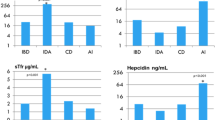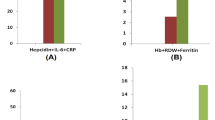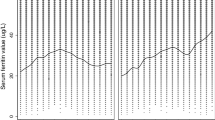Abstract
Background
Hepcidin is a master regulator of iron metabolism. Recently, it has been shown that vitamin D suppresses hepcidin expression. Our hypothesis was that hepcidin levels inversely correlate with vitamin D levels in anemic children during acute infection.
Methods
A prospective study was performed on 90 patients (45 females, 45 males, mean age 7.3 ± 5 years) who were admitted to the pediatric ward. Sixty-two patients had infectious disease (32 with coexisting anemia, 30 without anemia), and 28 patients were hospitalized for noninfectious causes. Blood samples for IL-6, hepcidin, iron status parameters, and 25-hydroxyvitamin D (25-OHD) were obtained within 72 h after admission.
Results
Serum concentrations of IL-6 and hepcidin were significantly higher and 25-OHD, iron, and transferrin were significantly lower in anemic children with infectious disease compared with controls. Children with a serum 25-OHD level < 20 ng/ml had significantly increased odds of having anemia than those with a level > 20 ng/ml (OR: 6.1, CI: 1.15–32.76). Correlation analyses found positive associations between hepcidin levels and ferritin (R2 = 0.47, P < 0.001) and negative associations between hepcidin and transferrin (R2 = 0.57, P < 0.001).
Conclusion
Higher IL-6 and lower 25-OHD levels may lead to higher hepcidin levels and subsequently to hypoferremia and anemia in children with acute infection.
Similar content being viewed by others
Log in or create a free account to read this content
Gain free access to this article, as well as selected content from this journal and more on nature.com
or
References
Weiss, G. & Goodnough, L. T. Anemia of chronic disease. N. Engl. J. Med 352, 1011–1023 (2005).
Weiss, G. Iron metabolism in the anemia of chronic disease. Biochim. Biophys. Acta 1790, 682–693 (2009).
Ganz, T. & Nemeth, E. Hepcidin and iron homeostasis. Biochim. Biophys. Acta 1823, 1434–1443 (2012).
Ganz, T. Hepcidin, a key regulator of iron metabolism and mediator of anemia of inflammation. Blood 102, 783–788 (2003).
Schmidt, P. J. Regulation of iron metabolism by hepcidin under condition of inflammation. J. Biol. Chem. 290, 18975–18983 (2015).
Girelli, D., Nemeth, E. & Swinkels, D. W. Hepcidin in the diagnosis of iron disorders. Blood 127, 2809–1 (2016).
Nemeth, E. et al. Hepcidin regulates cellular iron efflux by binding to ferroportin and inducing its internalization. Science 306, 2090–2093 (2004).
Nemeth, E. et al. IL-6 mediates hypoferremia of inflammation by inducing the synthesis of the iron regulatory hormone hepcidin. J. Clin. Invest 113, 1271–1276 (2004).
Lee, P., Peng, H., Gelbart, T., Wang, L. & Beutler, E. Regulation of hepcidin transcription by interleukin-1 and interleukin-6. Proc. Natl Acad. Sci. USA 102, 1906–1910 (2005).
Bacchetta, J. et al. Suppression of iron-regulatory hepcidin by vitamin D. J. Am. Soc. Nephrol. 25, 564–572 (2014).
Zughaier, S. M., Alvarez, J. A., Sloan, J. H., Konrad, R. J. & Tangpricha, V. The role of vitamin D in regulating the iron-hepcidin-ferroportin axis in monocytes. J. Clin. Transl. Endocrinol. 1, 19–25 (2014).
Smith, E. M. et al. High-dose vitamin D3 reduces circulating hepcidin concentrations: a pilot, randomized, double-blind, placebo-controlled trial in healthy adults. Clin. Nutr. 36, 980–985 (2017).
Sim, J. J. et al. Vitamin D deficiency and anemia: a cross-sectional study. Ann. Hematol. 89, 447–452 (2010).
Lee, J. A. et al. Low vitamin D levels are associated with both iron deficiency and anemia in children and adolescents. Pediatr. Hematol. Oncol. 32, 99–108 (2015).
Atkinson, M. A. et al. Vitamin D, race, and risk for anemia in children. J. Pediatr. 164, 153–158 (2014).
Smith, E. M. et al. Vitamin D deficiency is associated with anaemia among African Americans in a US cohort. Br. J. Nutr. 113, 1732–1740 (2015).
Abshire, T. C. & Reevers, J. D. Anemia of acute inflammation in children. J. Pediatr. 103, 868–871 (1983).
Jansson, L. T., Kling, S. & Dallman, P. R. Anemia in children with acute infections seen in a primary care pediatric outpatient clinic. Pediatr. Infect. Dis. 5, 424–427 (1986).
Kemna, E., Pickkers, P., Nemeth, E., van der Hoeven, H. & Swinkels, D. Time-course analysis of hepcidin, serum iron, and plasma cytokine levels in humans injected with LPS. Blood 106, 1864–1866 (2005).
Darton, T. C. et al. Rapidly escalating hepcidin and associated serum iron starvation are features of the acute response to typhoid infection in humans. PLoS Negl. Trop. Dis. 9, e0004029 (2015).
Deschemin, J. C. & Vaulont, S. Role of hepcidin in the setting of hypoferremia during acute inflammation. PLoS ONE 8, e61050 (2013).
Kim, A. et al. A mouse model of anemia of inflammation: complex pathogenesis with partial dependence on hepcidin. Blood 123, 1129–1136 (2014).
Alon, D. B. et al. Novel role of 1,25(OH)(2)D(3) in induction of erythroid progenitor cell proliferation. Exp. Hematol. 30, 403–409 (2002).
Lagishetty, V., Liu, N. Q. & Hewison, M. Vitamin D metabolism and innate immunity. Mol. Cell Endocrinol. 347, 97–105 (2011).
Zhao, N., Zhang, A. S. & Enns, C. A. Iron regulation by hepcidin. J. Clin. Invest 123, 2337–2343 (2013).
Adams, J. S. et al. Vitamin d-directed rheostatic regulation of monocyte antibacterial responses. J. Immunol. 182, 4289–4295 (2009).
Acknowledgements
Esther Eshkol is thanked for editorial assistance.
Author information
Authors and Affiliations
Corresponding author
Ethics declarations
Competing interests
The authors declare no competing interests.
Additional information
Publisher's note: Springer Nature remains neutral with regard to jurisdictional claims in published maps and institutional affiliations.
Rights and permissions
About this article
Cite this article
Moran-Lev, H., Weisman, Y., Cohen, S. et al. The interrelationship between hepcidin, vitamin D, and anemia in children with acute infectious disease. Pediatr Res 84, 62–65 (2018). https://doi.org/10.1038/s41390-018-0005-0
Received:
Revised:
Accepted:
Published:
Issue date:
DOI: https://doi.org/10.1038/s41390-018-0005-0
This article is cited by
-
Epstein-Barr virus infection and vitamin D deficiency are both “causal” for multiple sclerosis (MS) - could the common denominator be their effects on hepcidin levels?
Metabolic Brain Disease (2025)
-
Characterization of acquired anemia in children by iron metabolism parameters
Scientific Reports (2022)
-
The hepcidin concentration decreases in hypothyroid patients with Hashimoto’s thyroiditis following restoration of euthyroidism
Scientific Reports (2019)



